How To Coordinate Rugs In An Open Floor Plan Or Adjoining Rooms
Welcome to a comprehensive guide on coordinating area rugs in adjoining rooms or in open floor plans.
We’ll take a look at various rug styles, textures and color schemes to help you master the art of rug coordination. From neutrals to bold patterns, from sisal to jute rugs, we’ll cover it all.
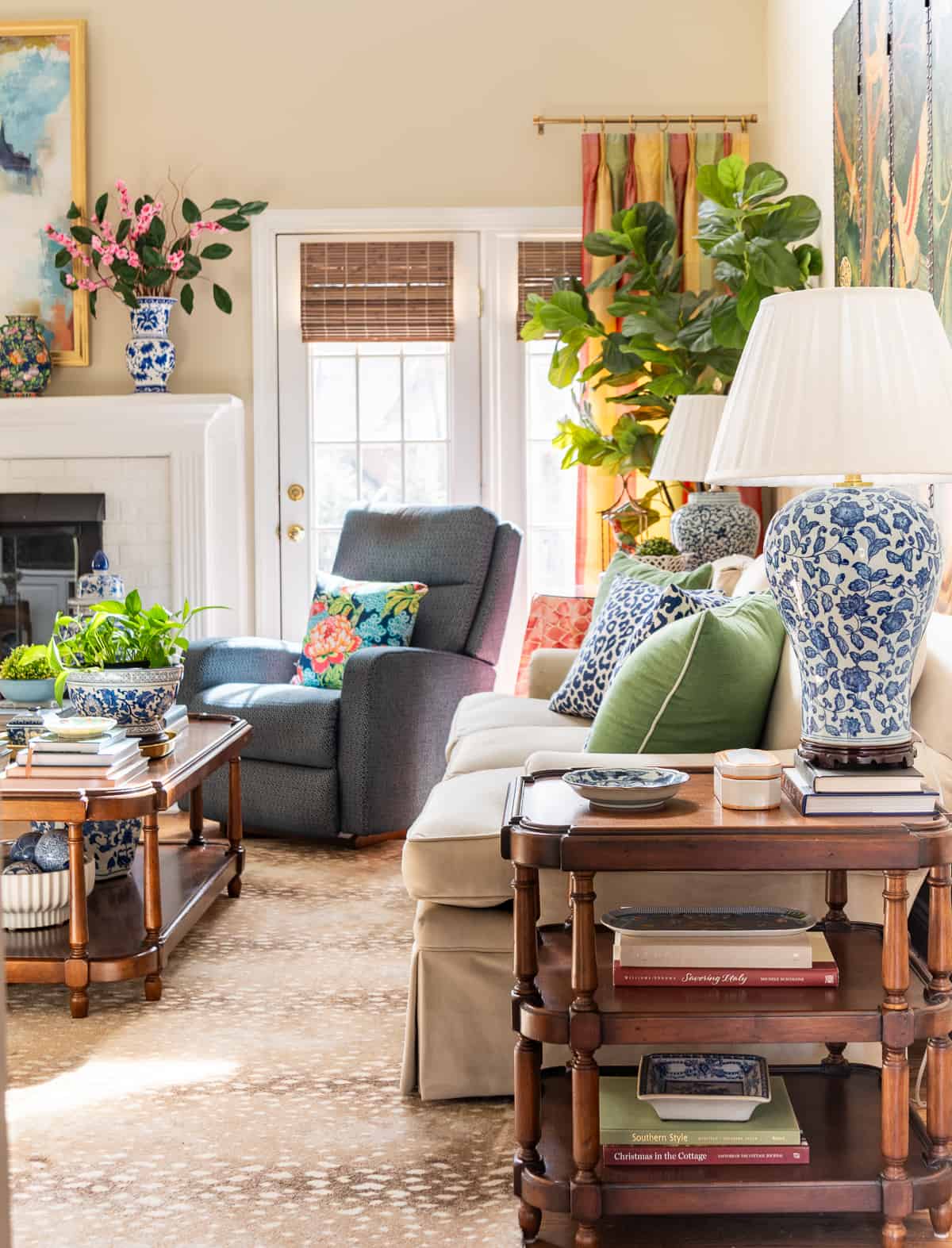
I’ve written about many design dilemmas over the years that I’ve been blogging. In fact, I’ve written an entire series to teach you how to decorate your own home.
Now that I’m redecorating our main living spaces, choosing rugs that work well together happens to be a new dilemma that I’ve been struggling with myself!
I’m sure that many of you struggle with the same thing, so down below, I’ve put together a roundup of three different rug color categories for you to use when shopping. Any of the rugs in each of the categories would work well together.
But first, let’s dive in and learn how to use two or more area rugs together, without them competing with one another.
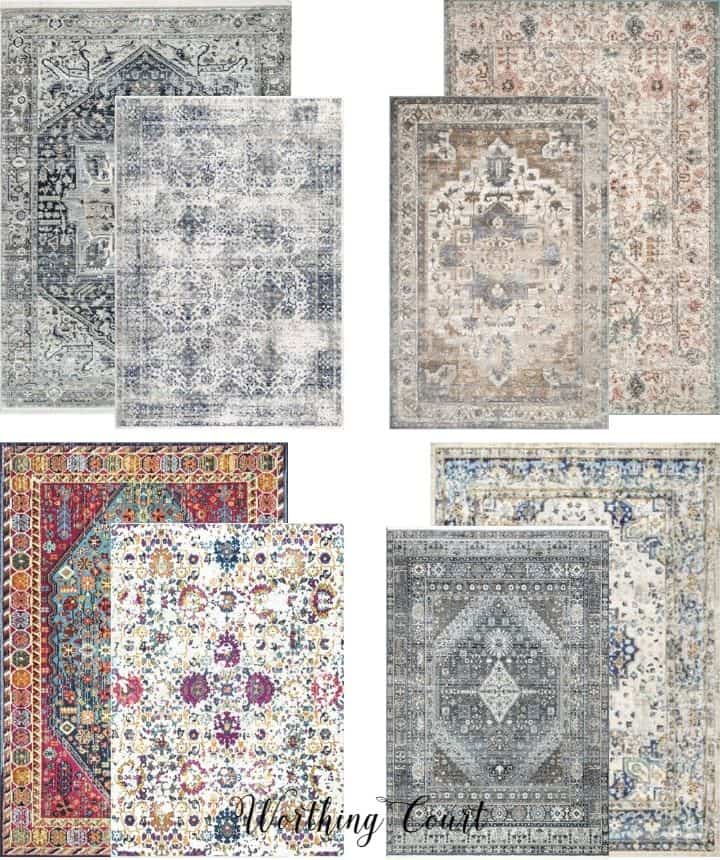
This post and photos may contain Amazon or other affiliate links. As an Amazon Associate I earn from qualifying purchases. If you purchase something through any link, I may receive a small commission, at no extra charge to you. All opinions are my own. See my full disclosure HERE.
Defining Spaces in Open Floor Plans
Open concept floor plans have become increasingly popular in interior design over the last couple of decades.
The key challenge to an open floor plan is to define distinct living spaces while maintaining a cohesive flow throughout.
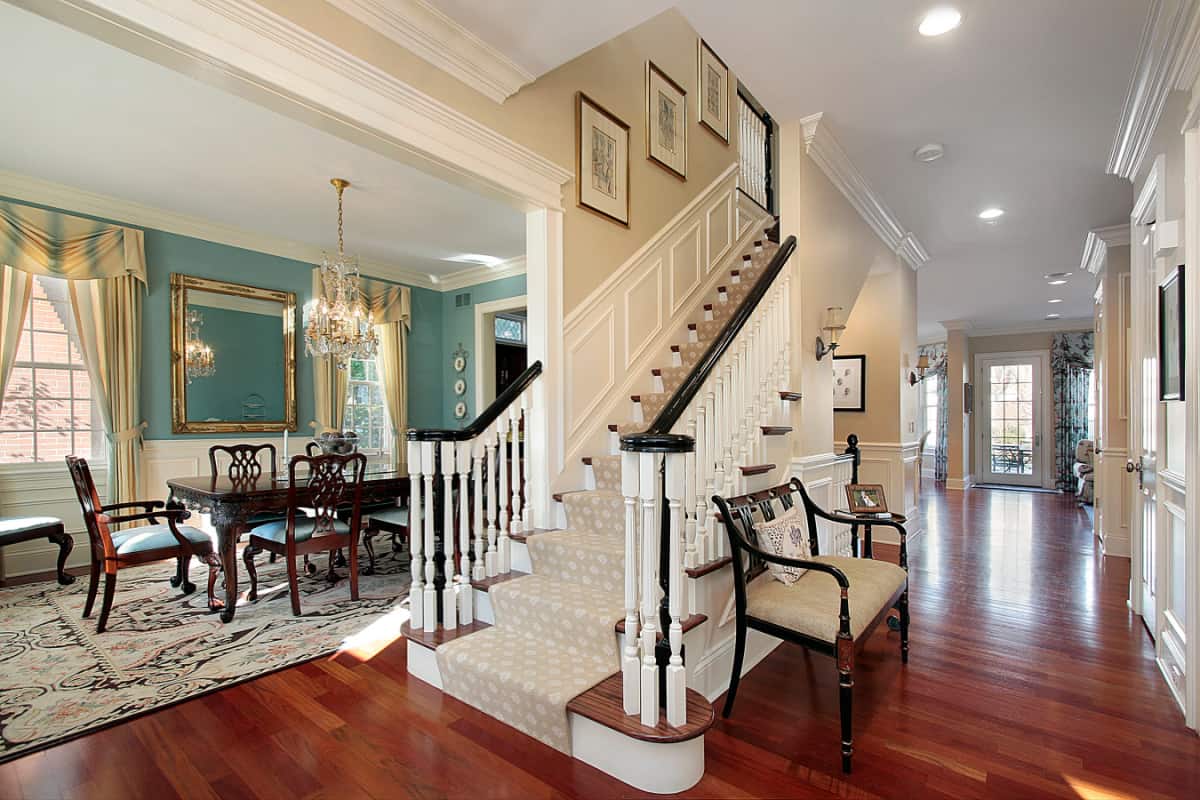
Using area rugs is an effective tool for visually separating different zones, such as the living room, dining area, and kitchen.
Start out by assessing the layout of your space and determining the function for each area and what shape rug will work best in each of the locations.
For example: a round rug will likely work best under a round table in a dining space, while a rectangular or square rug will probably be best for a living room or family room.
Runners, that match larger rugs, are often available and work well in front of a sink or down a hallway.
TIP: In a living room or family room, make sure that the area rug is large enough that at least the front two feet of your sofa and any chairs can rest on it. This will help to ground all of the furnishings and visually connect the entire seating area.
Coordinating Rugs In Adjoining Rooms
My foyer has two openings – one opens into our home office, which opens into the dining room (which is still a work-in-process room).
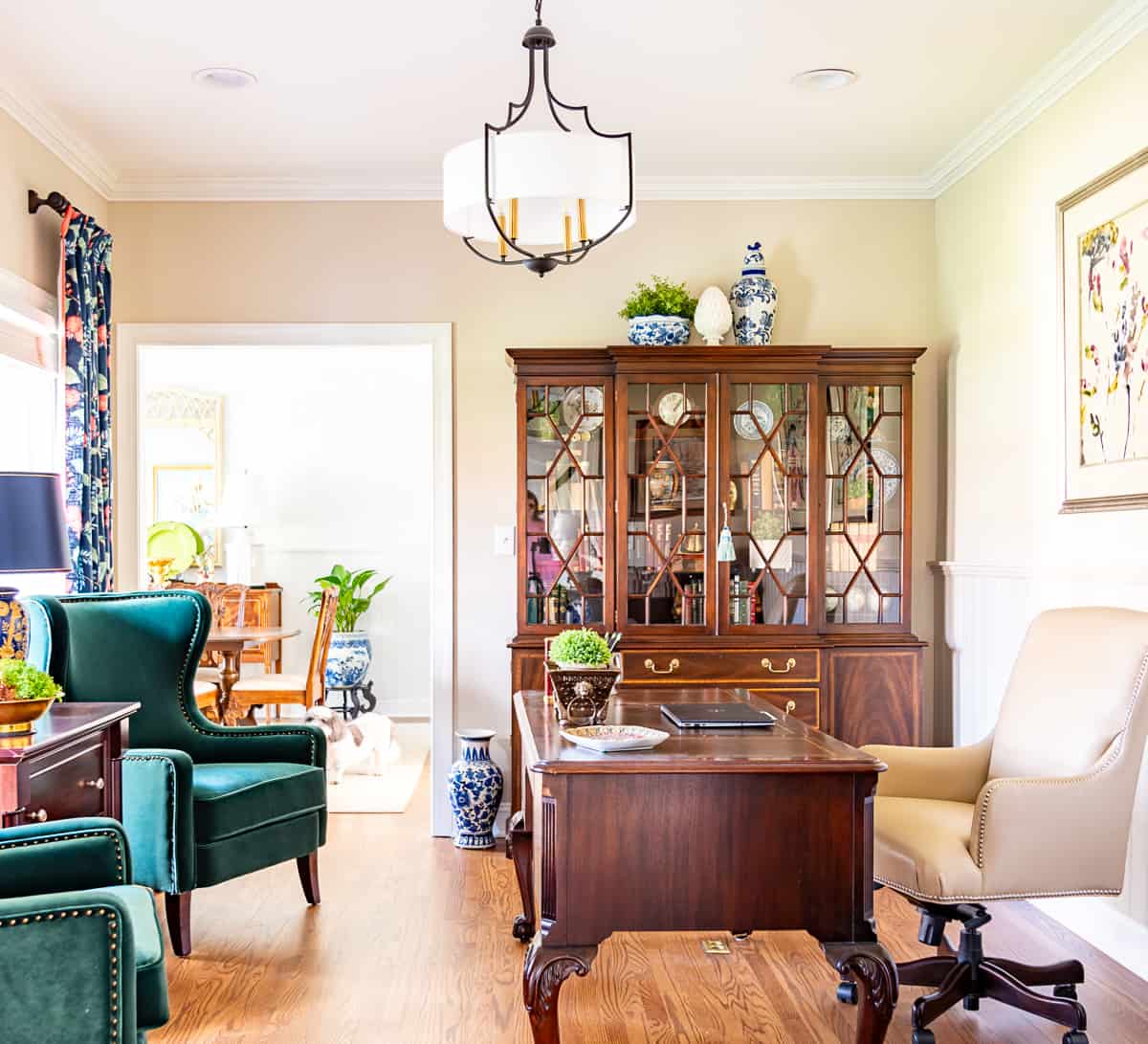
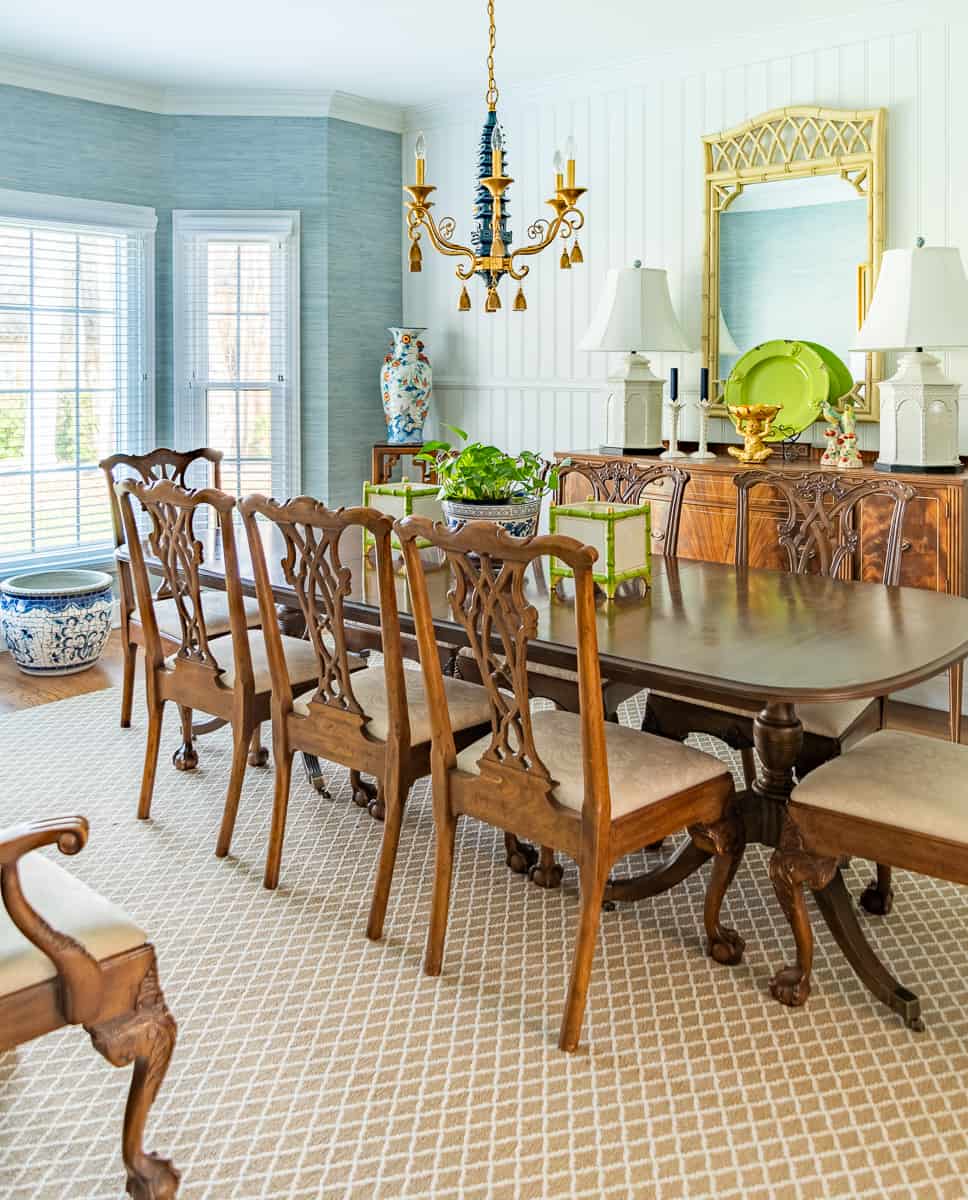
The other opens into the family room.
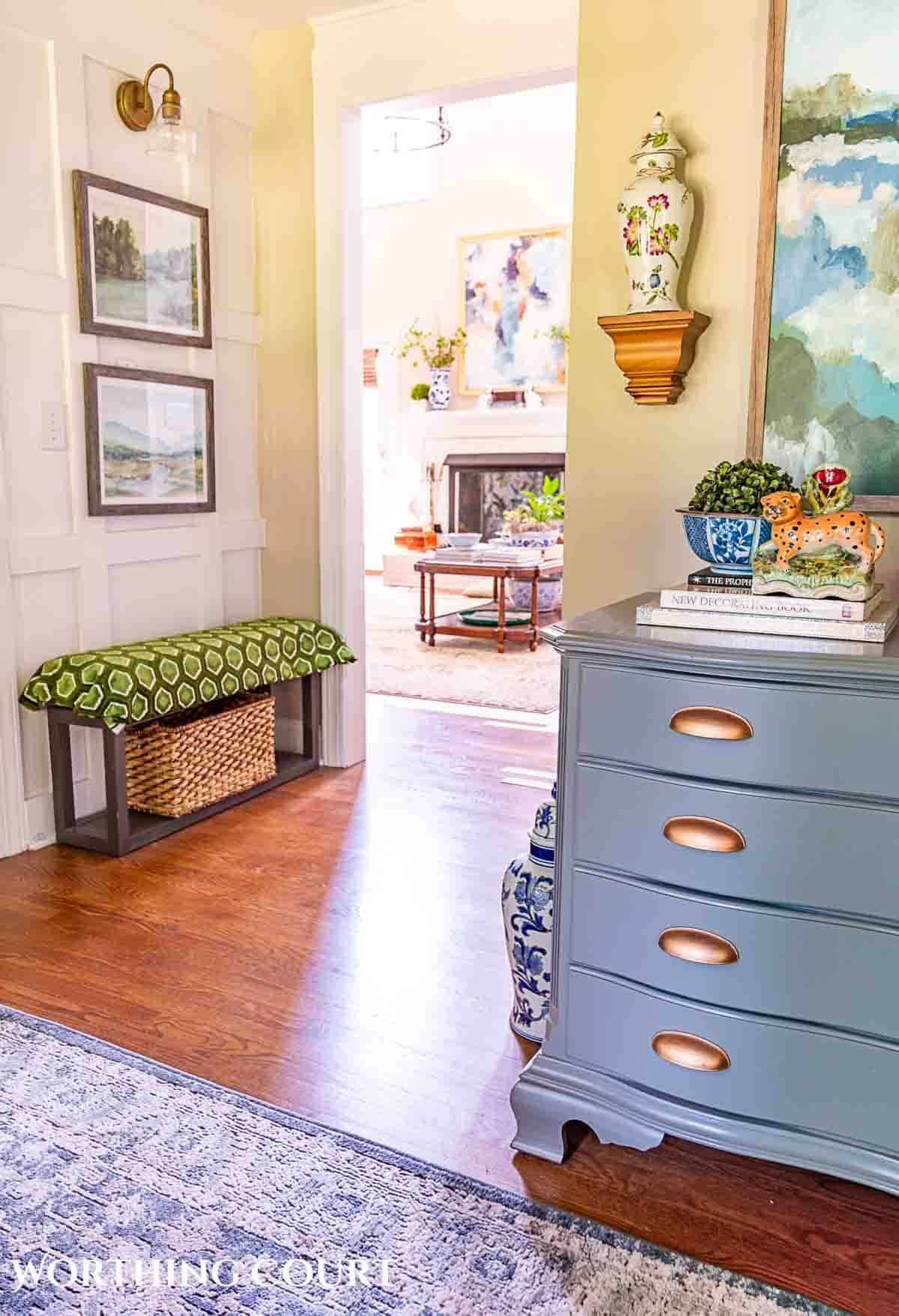
Even though I do my best to keep all of the decor cohesive between the rooms, finding area rugs for these three rooms, that don’t fight with one another, is something I’ve had to learn to do.
There are two tricks for coordinating rugs in adjacent rooms and achieving a cohesive look – one is with color and the other is with pattern.
As a general rule, begin by identifying the primary color scheme used in both rooms. Look for rugs with complementary colors or patterns that harmonize with each other.
For example: if the dining room features a geometric patterned rug in shades of blue, choose a coordinating rug for the living area that incorporates complementary blues in a different pattern or texture. This will create a visual connection between the rooms while allowing each rug to stand on its own.
Another example: use a large scale pattern in the living room with a solid color or small scale pattern in the dining room. Stripes work well with other patterns too.
TIP: Yes, you can have two different floral or geometric patterned rugs in the same area. The key is to vary the scale of each pattern (one small and one large) and to use the same or complementary colors.
Embrace Texture
Texture always plays a crucial role in the world of interior design, including the selection of area rugs.
Natural fiber rugs, such as sisal or jute, are excellent choices for introducing texture to your space. Their earthy tones effortlessly blend with different decorating styles and color schemes.
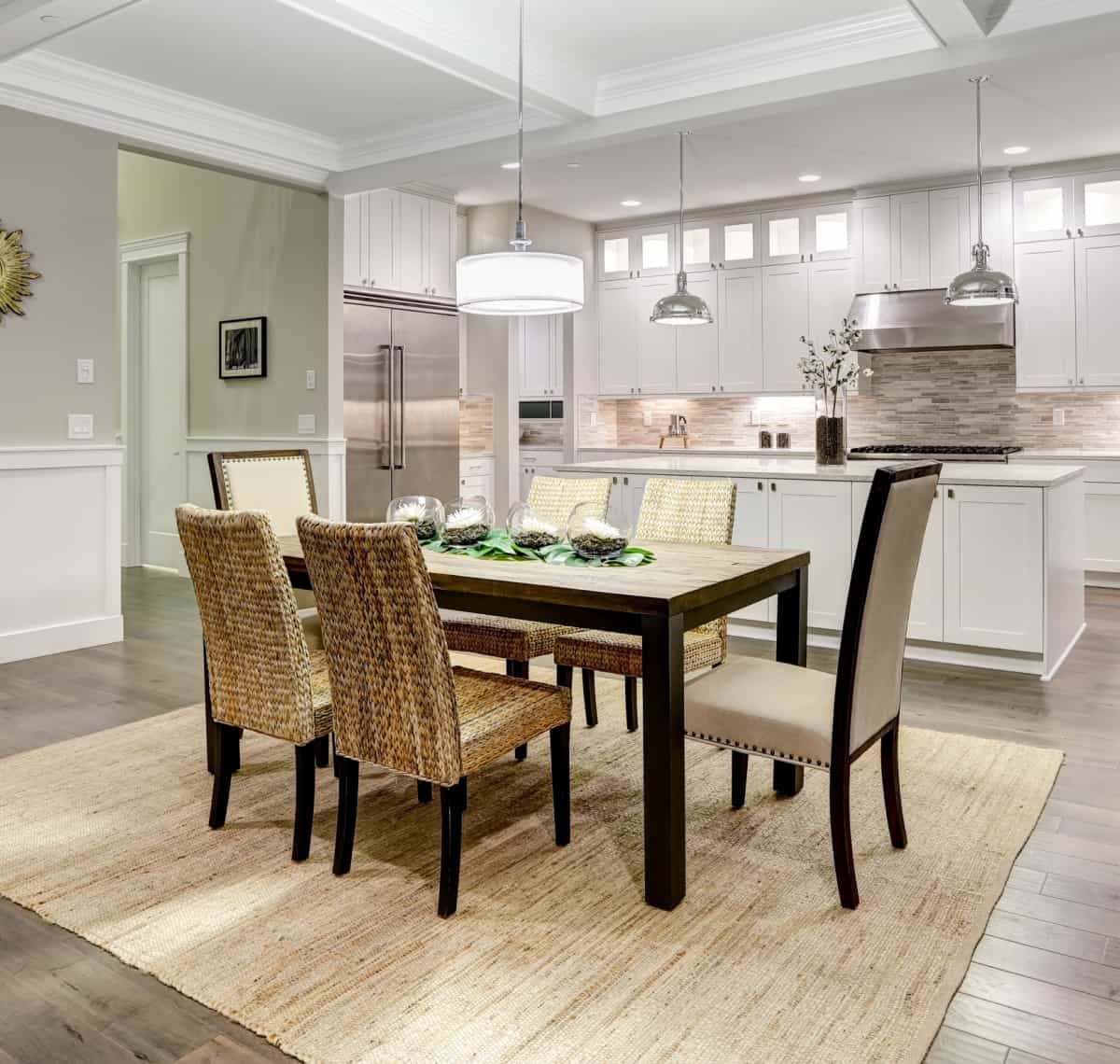
To create depth and visual interest, consider layering a neutral-toned jute rug underneath a patterned rug in a living area. The combination of textures creates an inviting space with instant coziness.
If natural fiber rugs aren’t your thing, consider adding texture with a wool rug. They can be a little pricier than synthetic rugs, but they offer a luxurious feel underfoot, are very durable and won’t show signs of wear for many years.
One way to add the appearance of texture, is to opt for a tone-on-tone area rug in an understated ivory or beige with a subtle pattern. Even better if the pile heights within the rug vary in size.
Layer Rugs for Depth and Dimension
Layering rugs is a popular technique that adds depth and dimension to any floor plan.
It allows you to combine different textures and patterns while creating visual boundaries between spaces.
This concept was great when my living room was decorated with neutral furnishings, but can work well in any situation with the right rug combination.
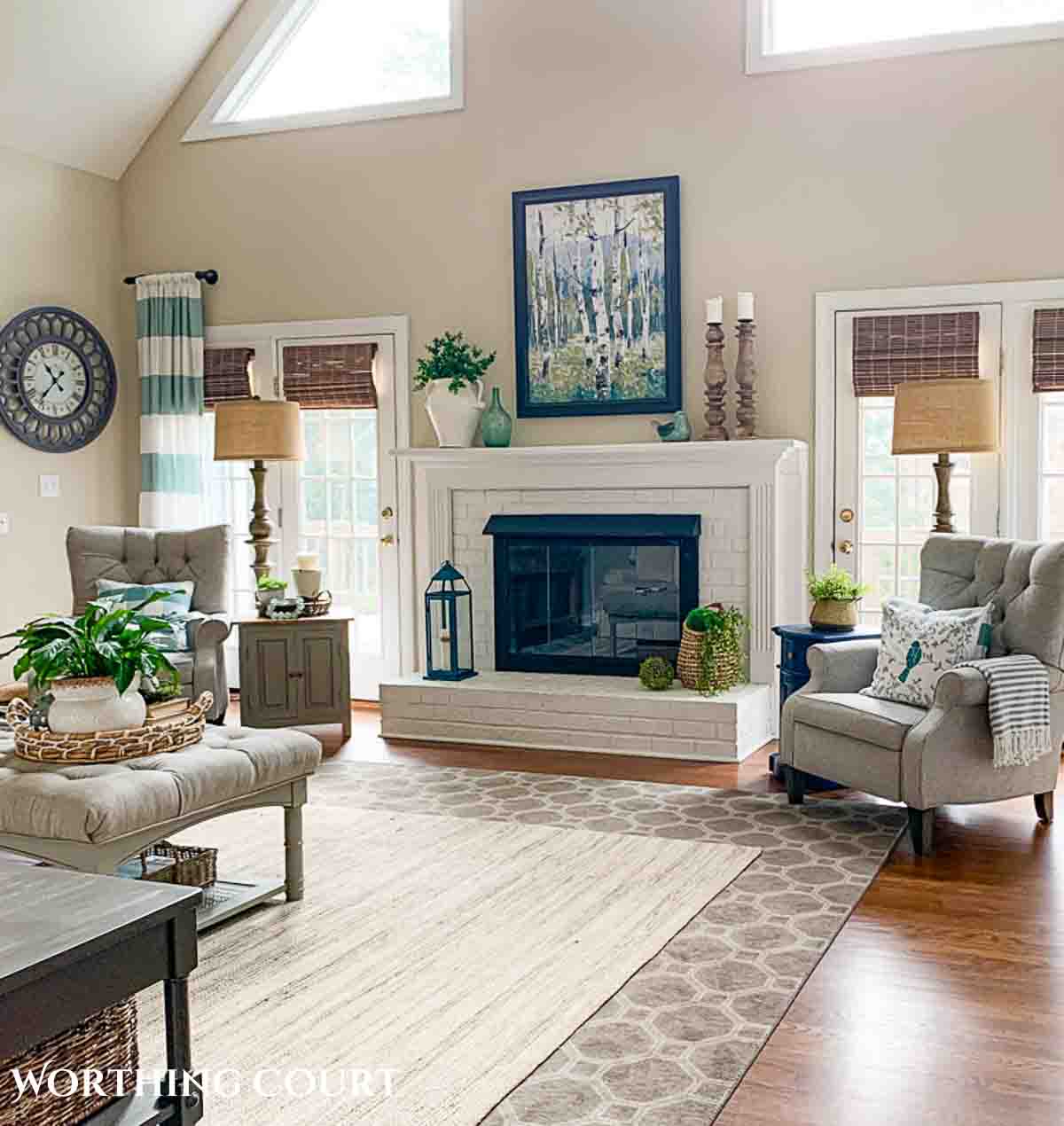
You’ll see it done most often with a living room rug, but it also works well in a bedroom.
Start by selecting a larger area rug, with either no pattern or a small scale pattern, as the base layer, preferably in a neutral color or natural fiber. For example, a sisal rug can serve as a durable and neutral colored foundation.
On top of the base rug, add a smaller rug with a bolder pattern or color scheme. This can be a geometric or patterned rug that complements an adjoining room or introduces a new element to the overall design.
The layering technique adds visual interest and allows you to experiment with various rug styles to create a truly unique and personalized look.
TIP: Layering one rug on top of another is the key to adding instant coziness and a feeling of having decor that has been collected over time to a room.
Coordinating Neutrals for a Timeless Look
Neutral rugs aren’t boring and are a staple when it comes to pulling rooms together. They provide a foundation that is versatile and are one of the easiest ways to complement various design styles and color palettes.
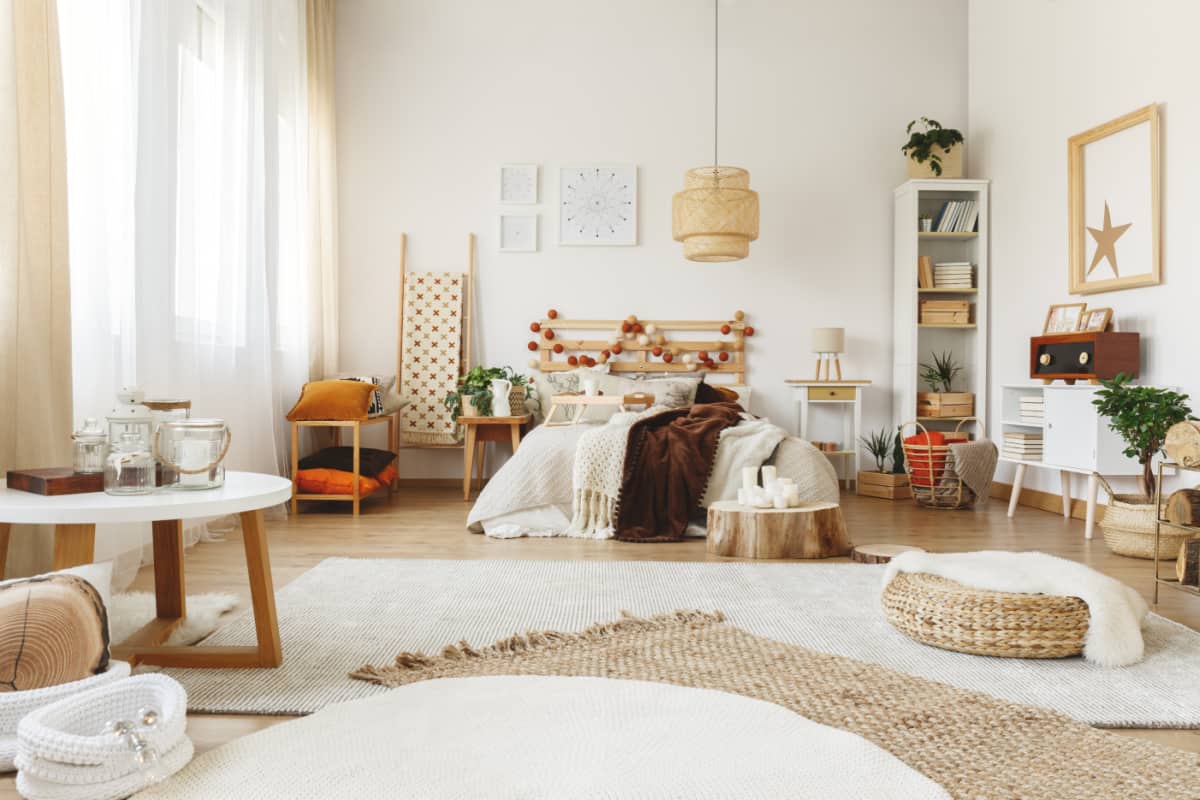
Consider incorporating them into your open floor plan in colors such as ivory, cream or beige.
The combination of neutrals, in various tones and patterns, creates a harmonious and balanced atmosphere throughout your space.
TIP: When it comes to large items such as rugs, furniture and walls, having a neutral color palette creates a timeless design that can adapt to evolving decor trends and your own personal changes in taste.
Harmonizing Colors and Patterns
If a color scheme is your main consideration when purchasing a rug, you don’t have to use colors that match.
Using rugs in differing shades of complimentary colors will give a cohesive visual flow throughout a space.
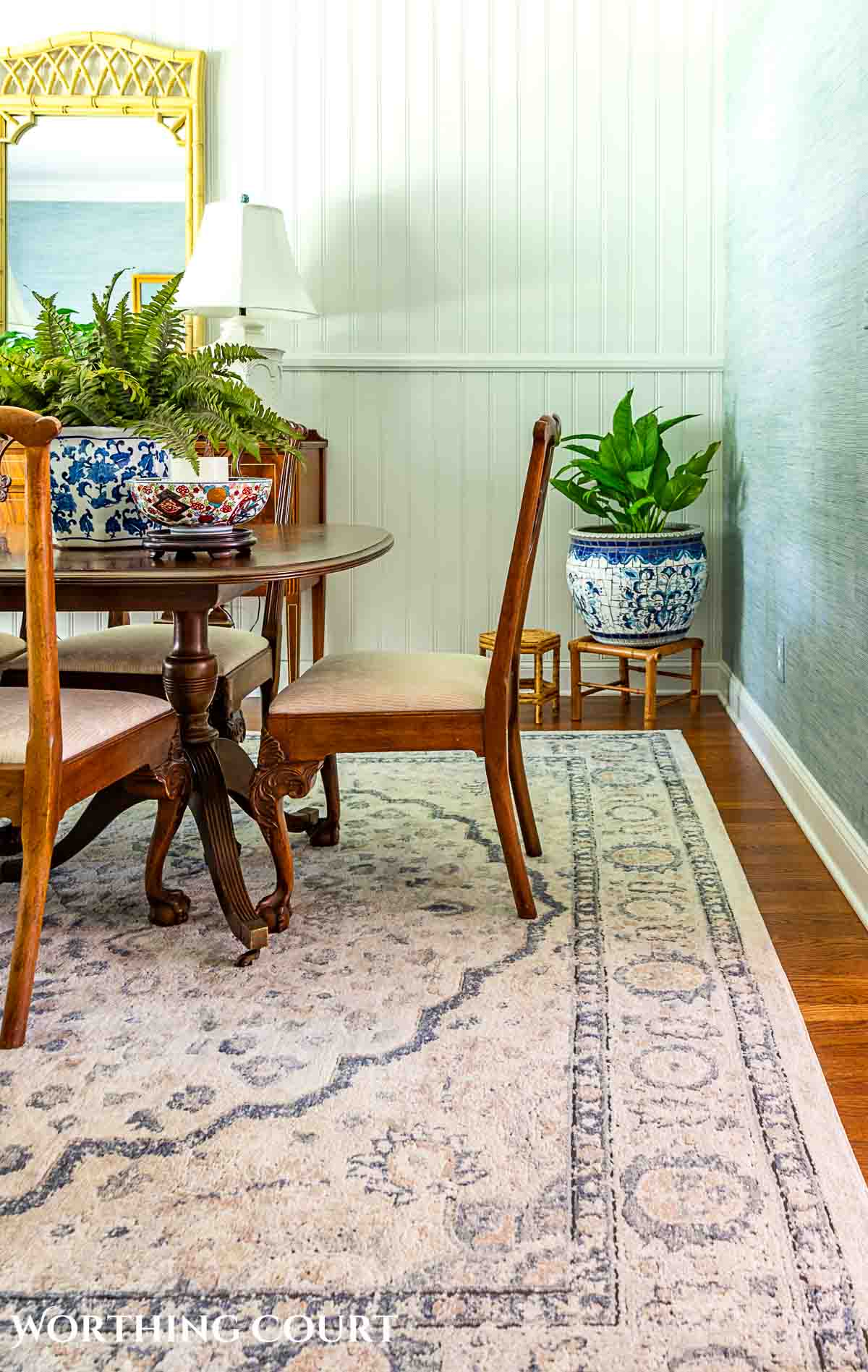
Can you pair warm earth tones or shades of gray with cool, vibrant colors? Absolutely! Just be sure that there is some shade of the dominant color in each of the rugs to help them tie together.
Additionally, consider the scale of patterns when coordinating rugs. A large-scale pattern on one rug can be balanced by a smaller-scale pattern on another.
Alternatively, you can choose rugs with similar patterns but in different scales to create a coordinated yet visually interesting look.
Matching Rugs for a Unified Look
To achieve a truly unified look in your open floor plan, consider incorporating rugs with matching colors throughout the space.
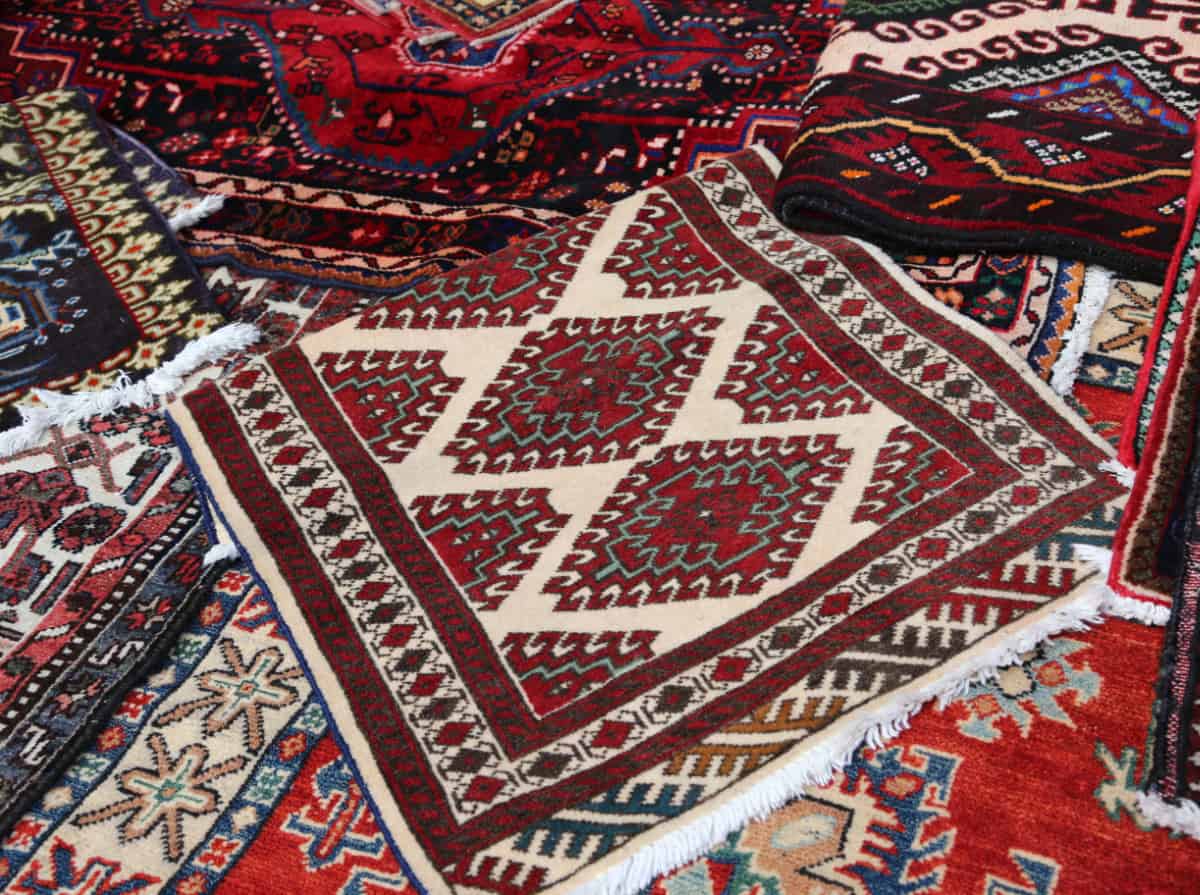
It’s a no-fail way to create cohesiveness and visual continuity.
If you use rugs that are an exact match, add interest by using different sizes and shapes of the same rug pattern.
In Summary
To create a cohesive look across open floor plans, it’s important to consider the overall design and style of your space. Choose rug styles that complement your existing decor and reflect your personal taste.
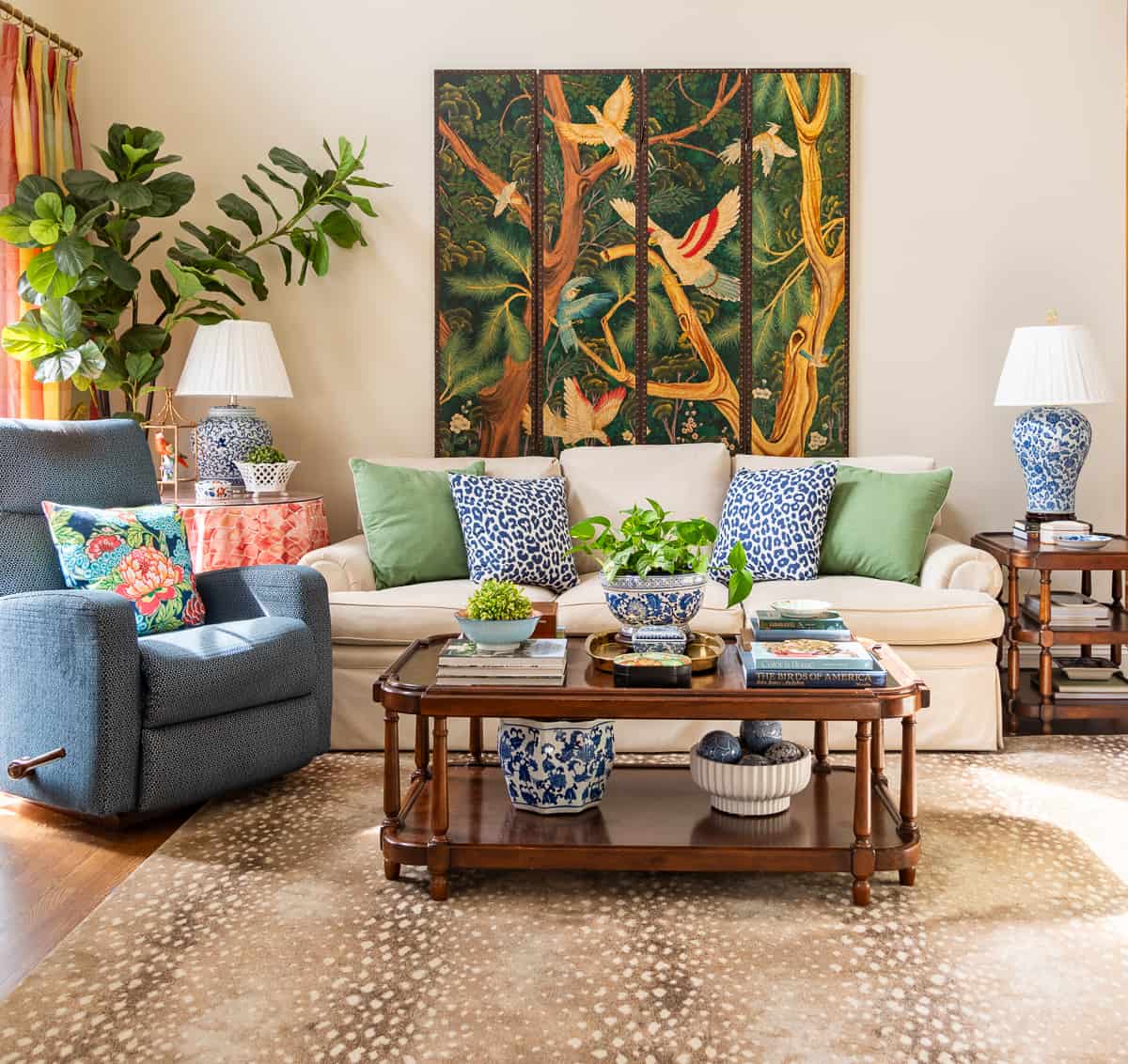
For example, if your interior design leans towards a contemporary aesthetic, opt for rugs with clean lines and geometric patterns. If you prefer a more traditional or bohemian style, look for rugs with intricate designs or vibrant colors.
To tie the entire space together, select rugs with complementary colors that are repeated throughout different areas. This repetition of colors creates a sense of unity and harmony.
Additionally, consider incorporating elements of texture to add visual interest and variety. Mix natural fiber rugs, like jute or sisal, with rugs featuring different pile heights or materials to create a layered and textured look.
Whether you’re defining spaces in an open-concept floor plan, coordinating rugs in adjoining rooms, or aiming for a cohesive look across your entire living space, these tips and techniques will help you create a harmonious and inviting environment that reflects your personal style.
CHECK OUT THESE GREAT RUG COMBOS
Natural Fiber Rugs
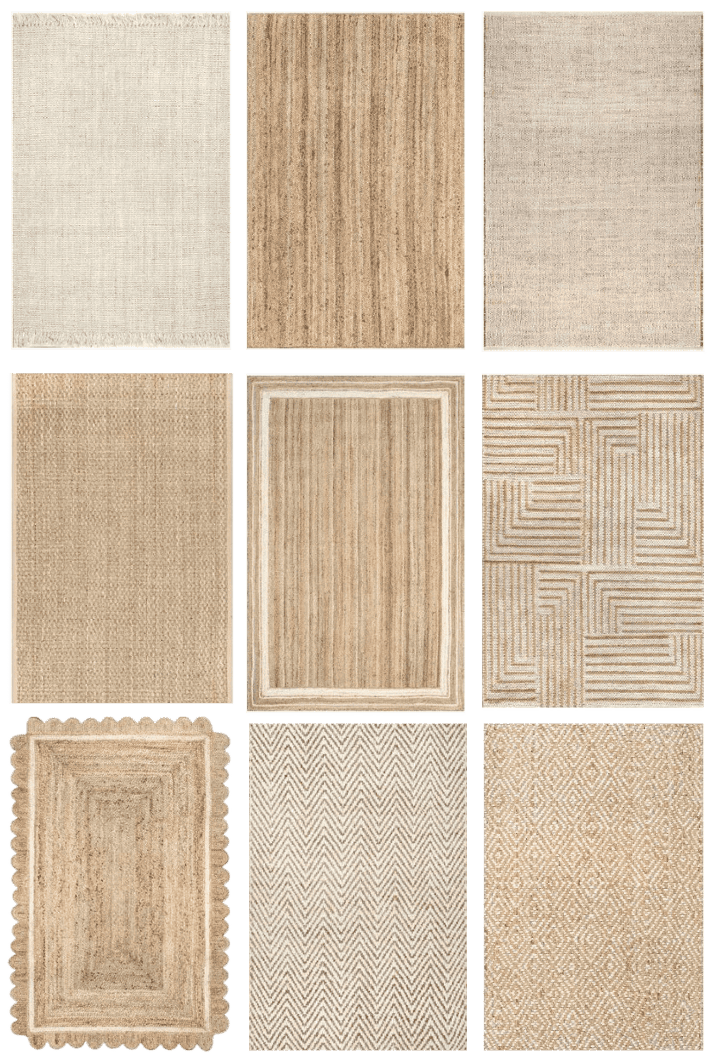
Chunky Jute With Tassels | Braided Jute Rug | Hand-woven Jute Blend
Checker Weave Seagrass | Braided Jute With Border | Grassland Hand-woven Jute
Anna Scalloped Jute | Hand-woven Chevron | Hand-woven Birdseye Diamond
Ivory and Gray with Blue
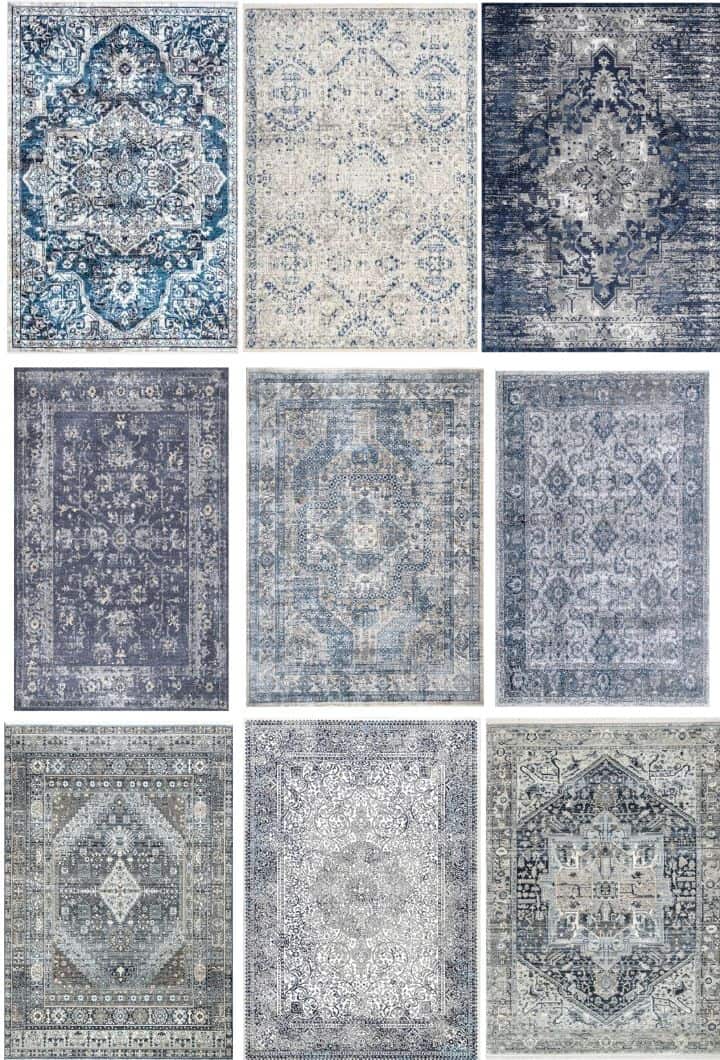
1) Blue Shaded Medallion 2) Blue Honeycomb Labyrinth 3) Shaded Medallion
4) Blue Bordered Floral 5) Distressed Medallion 6) Oriental Herati
7) Hectoria Shaded Medallion 8) Persian Wreath 9) Dark Blue Tasseled Medallion
Ivory and Gray with Tan
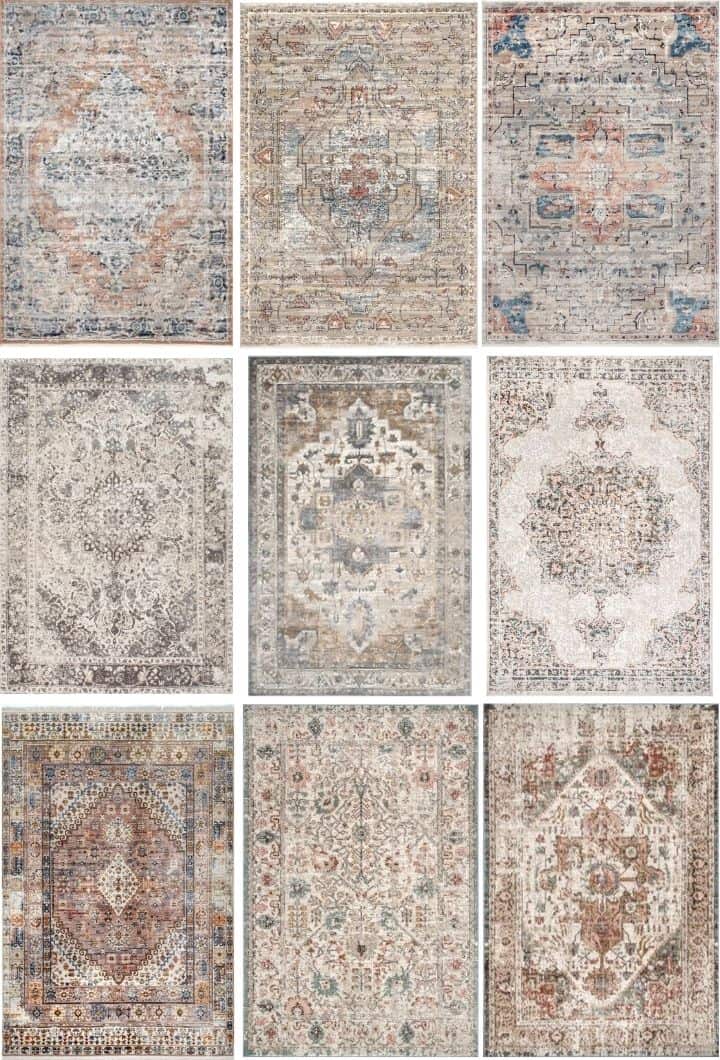
1) Shaded Snowflakes 2) Cardinal Cartouche 3) Croix Medallion
4) Garnished Medallion 5) Crested Venetian 6) Faded Sun Medallion
7) Distressed Medallion 8) Native Collage 9) Fading Herati
Multi Colored and Vibrant
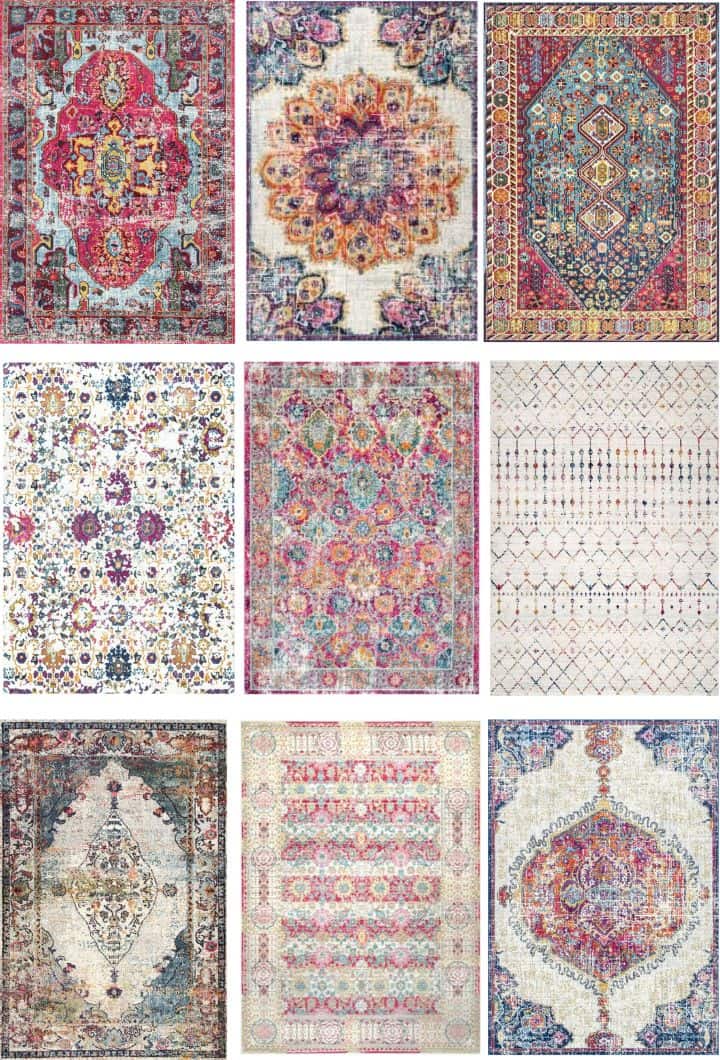
1) Multi Mosaic 2) Withered Bloom 3) Vibrant Meadow
4) Cardinal Peony 5) Mardin Regal 6) Moroccan Trellis
7) Fading Oriental Medallion 8) Muted Floral 9) Frilly Corinthian
The possibilities are endless. Just remember that each rug is a unique representation of your personality and design style. And don’t worry about breaking any so called “rules”. It’s your home – make it a place that you love!
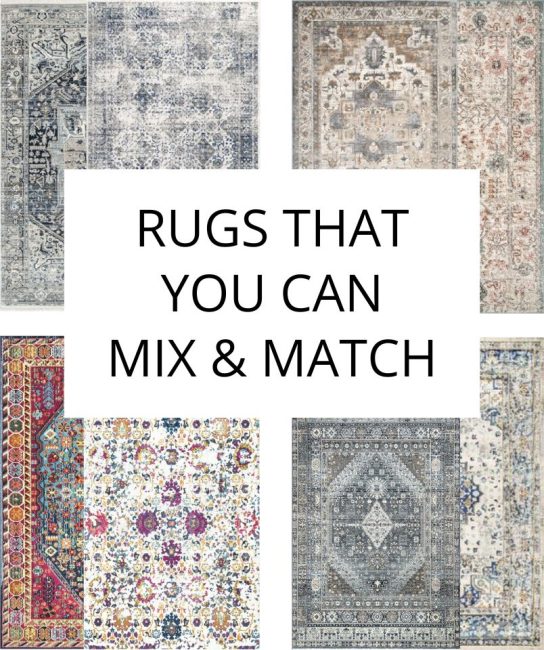
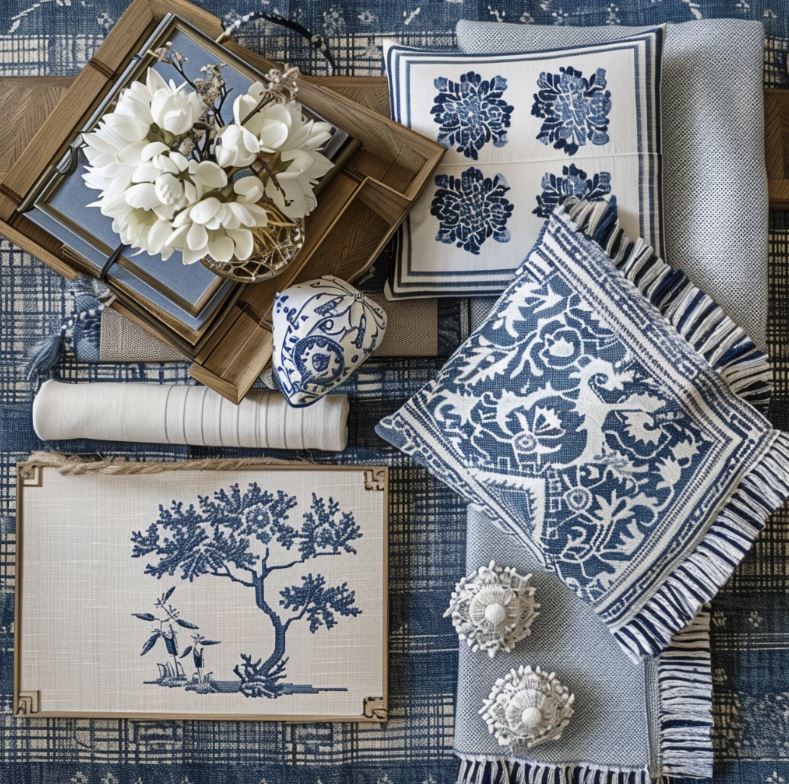
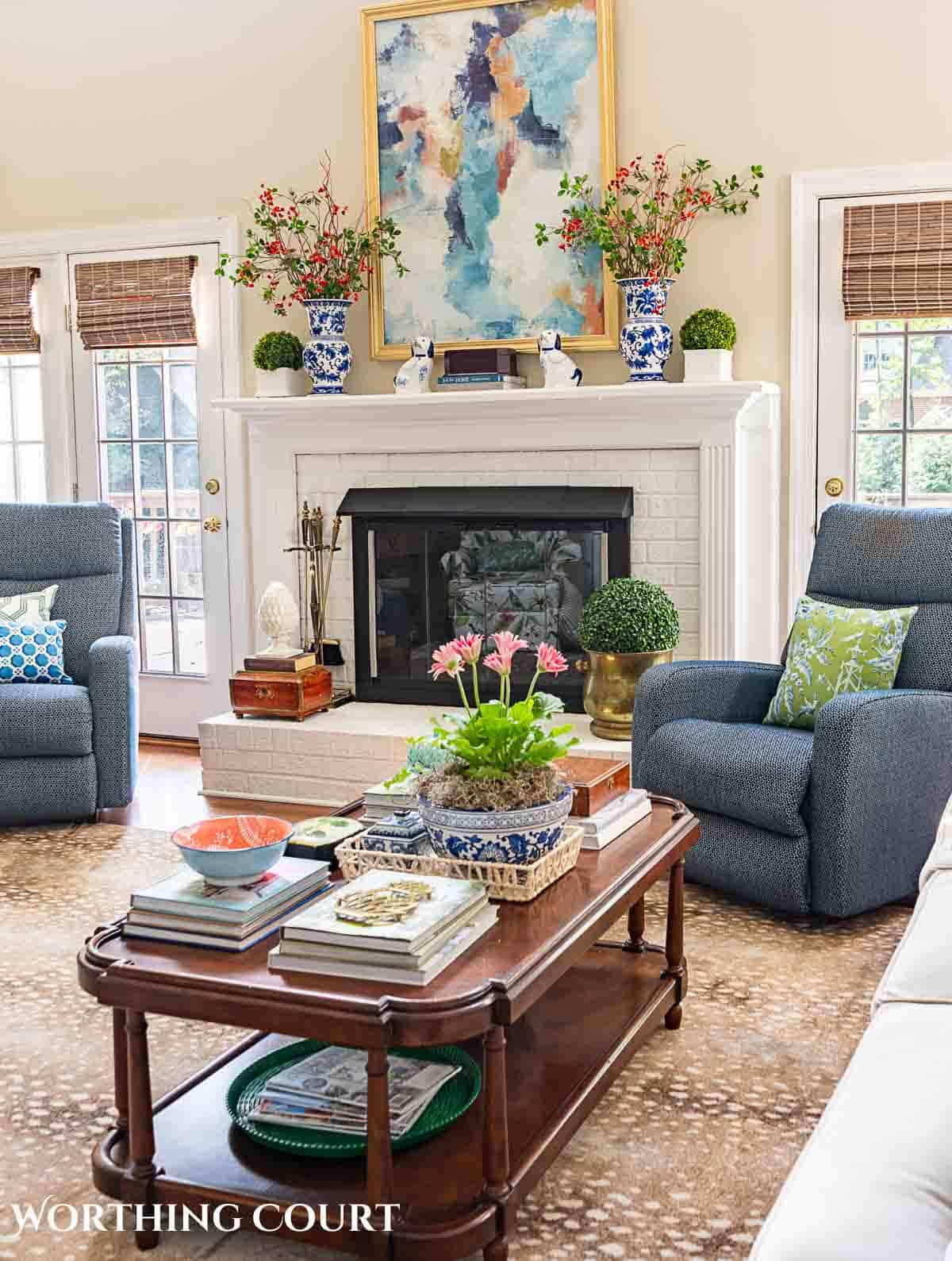
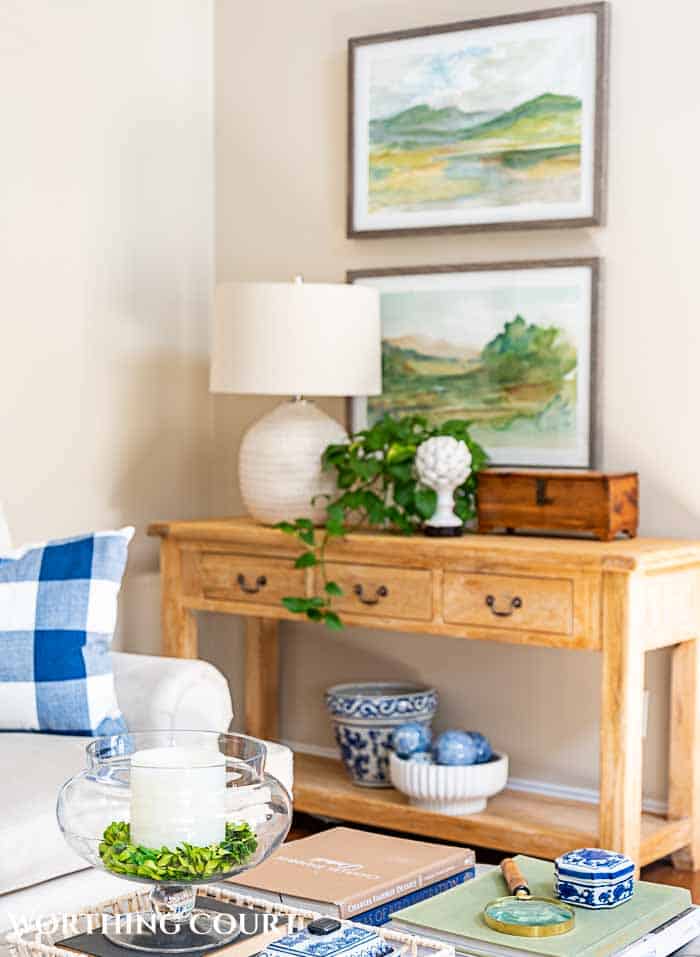

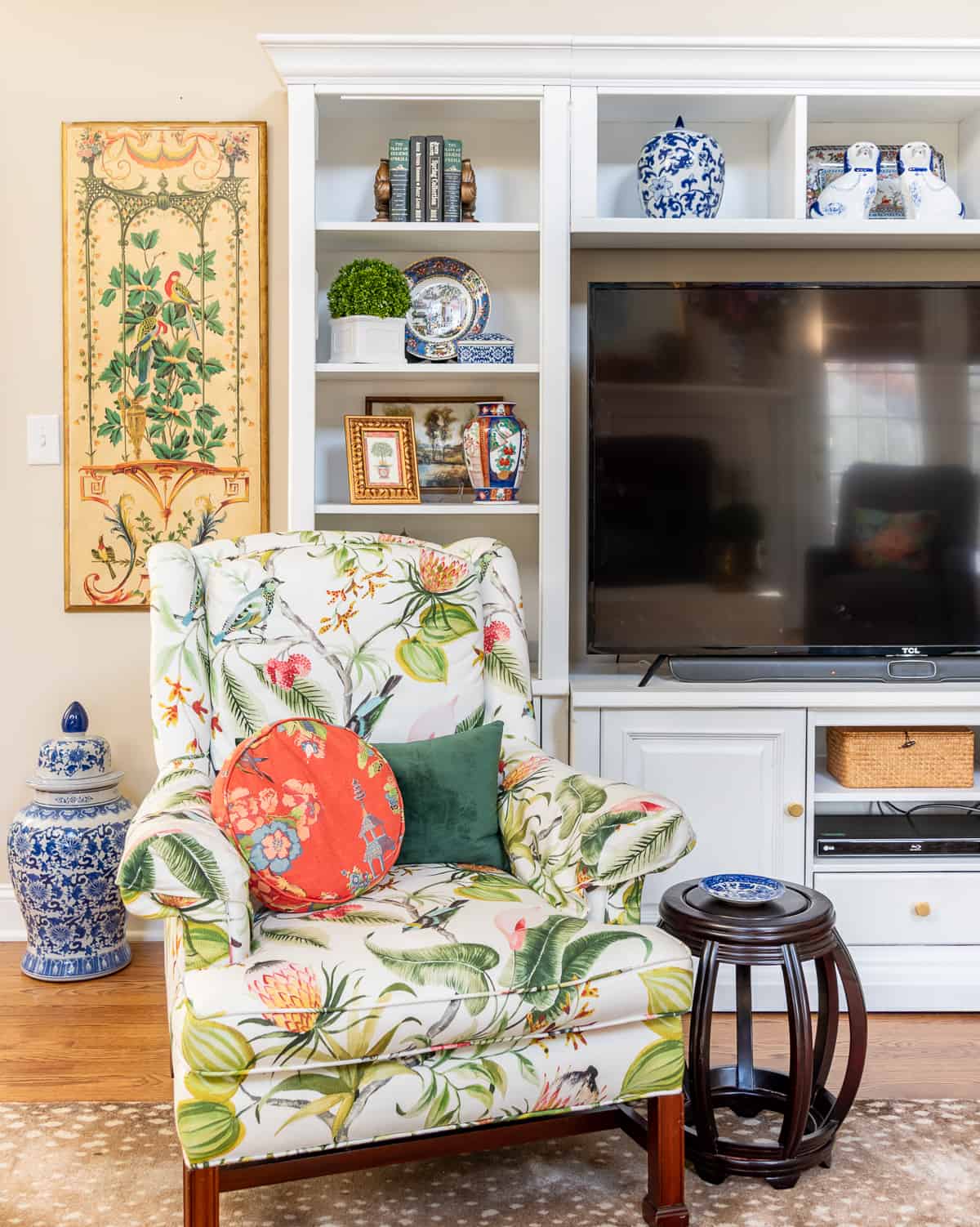
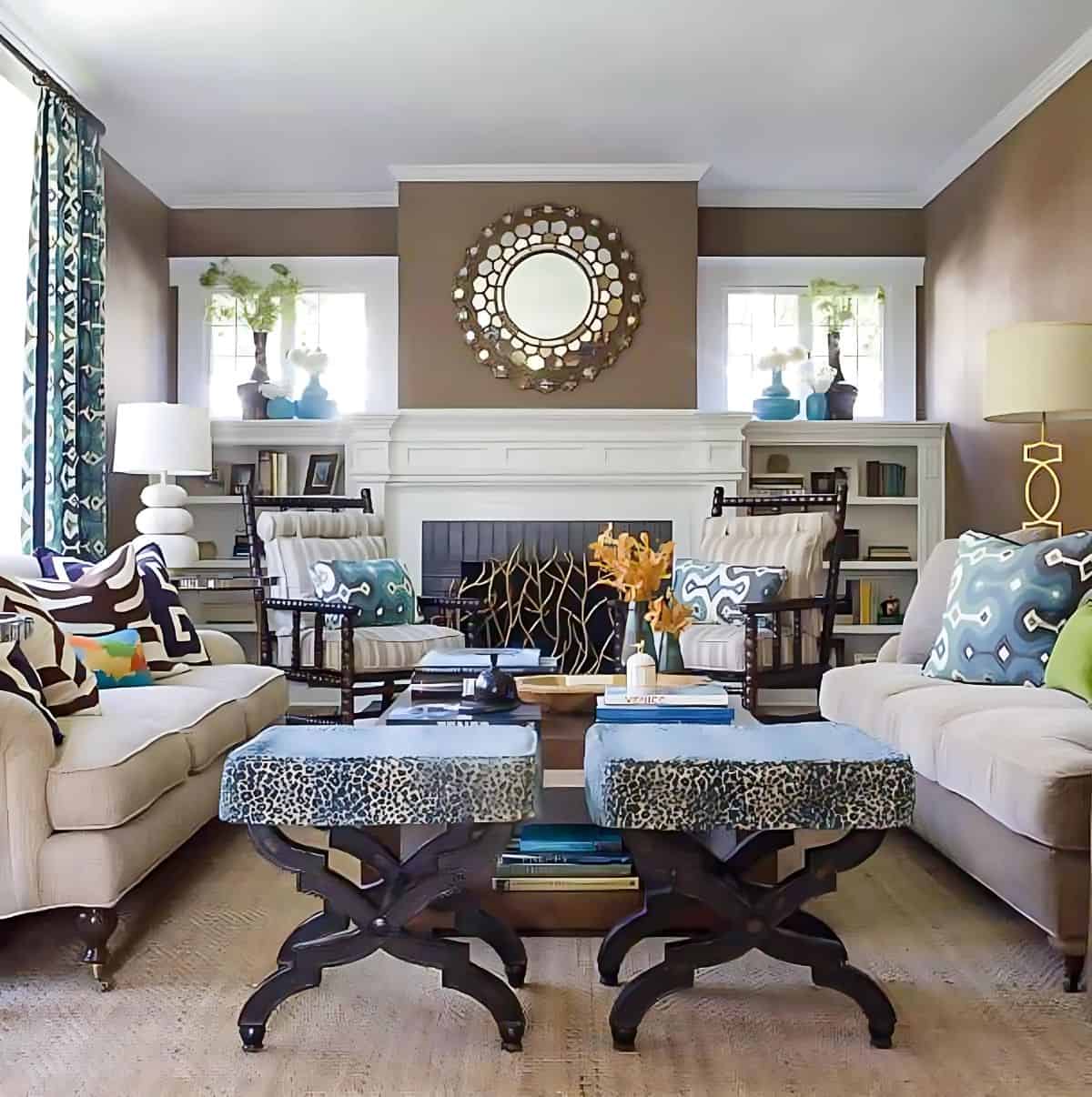
These are great tips, I wish I would have found this article sooner! I bought a kitchen area rug from a local store about a year ago to match a rug in my dining room, and it looks great but gets dirty incredibly fast. I’ve already had it cleaned by a rug cleaner twice. I wish I would have done more research and went with a washable rug!
Glad you found the tips helpful! Maybe you can save them for the next time you need a new rug.
Love your blog! Are your floors hardwood or LVP? They are beautiful!
Thank you! Our floors are oak hardwood that have been stained with Minwax Special Walnut.
Suzy, Great post. The visual pairing of the “nines” is a great reference tool. Thank you so much for always hands on teaching. Love peeking into your designs in your home.
Hi Suzy, Thanks for the great post. It’s already pinned on Pinterest, for future reference. So many choices!! Btw, I absolutely love the color of the little dresser in your foyer! If you painted it, could you please tell me what color you used. If you bought it that way, where did you get it? I have a small dresser that I want to re-do and have been struggling with finding the right color. Any info would sure be appreciated. Thank you.
Glad you found this useful! The chest in my foyer is an old cherry chest that I painted with Sherwin Williams Network Gray. 😀
I love the little blue painted piece of furniture in the foyer. What color is it? I so enjoy your blog. Blessings to you from North Carolina. Gina
Hi Gina. I actually don’t have any blue furniture in the foyer. Sometimes that gray chest comes across as blue, but it’s actually an old cherry chest that I painted with Sherwin Williams Network Gray. Please let me know if that isn’t what you’re asking about though.
Glad I found this and other blogs however all of them address two modern rugs. Do you have any advice for pairing a rug with an heirloom oriental? I’m looking for something to go under my table that next too my living space in my open floor plan. Im not sure I’d choose this rug for my self but because of its history would like to keep it and put something near to by. I just ordered a rug to try and didn’t like the way it looked. Any advice on what to put under the table when this oriental has the traditional dark blues and reds (not exactly modern). I’m in my late 20s and have really been trying to learn about decorating.
I have this same question. Your thoughts?
Hello ! Trying to find a rug to go with a rig I have in living room. This has been a job I hope u can help. I have a cream color zebra print and now looking for something that will work with the whole animal thing. Any suggestions?
I think that solids, stripes, florals, plaids and paisleys could all go with a zebra print. It’s difficult to say exactly without me seeing your room, but personally I would prefer a solid as mixing patterns with zebra can be tricky. If you go the solid route, I would look for something that’s a darker shade than your rug. Hope this helps a little!
Hallo!
I have a beautiful Pakistan silk wool jaldar carpet in my dining room.Dark red color and whitish grey borders.
What can I match next to it in an open living – dining room ?
Thank you
That sounds like a beautiful rug! I’d need to see a picture of it and the spaces that you want rugs in to be able to help you. I’d be happy to do that if you’d like to email me some photos. My email address is: worthingcourtblog@gmail.com
Thank you so much for posting this, it is super insightful! We bought a new home in 2022 and we have been slowly replacing the furniture in preparation to paint away the asylum white walls and now that our furniture is only a few short weeks from delivery I am under the gun to pick some rugs for our open concept living and dining room area. My husband and I have been going back and forth on two rugs that we love and we’re convinced we had to make things matchy because of their proximity but this gives me hope that we could make them work together! One rug is more classic bordered “oriental” style pattern, while the other is large floral/medallion – both with very similar color palettes (cream, grey, teal/aqua & navy)- which is the overall color palette of the whole area. I am much less terrified of combining them after reading your blog and some others all urging the same thing, to be brave. 😉 Thanks so much!!
I’m so glad you found this helpful! Thank you for letting me know.
This post came just when I needed it!
Hello Suzy,
Thank you for this article, it is truly insightful. We have recently moved to a new home and in process of furnishing the space. I have a mix of leather – camel color (towards brown) 89′ wide sofa against the wall and 2 dark blue fabric sofa (79″ inches) and 52″ inches facing each other ( U living room arrangement) I have oak colored LVP flooring. Presently, looking for matching area rugs for dining and living area. Looking for something that brings flow in the living room considering mix textured furniture and dining area.
I would appreciate your suggestion on following. Thanks in advance.
1. Should I go for a mix of rugs in living and dining based on the suggestion above or just stay in one kind with different size for dining and living?
2. Considering mix of furniture in the living what color tone would work the best?
Thanks
Shraddha
I’d look for two rugs that look well together instead of two matching rugs, but I really can’t give you specific advice without seeing your spaces. I’d go with rugs that have both brown and blue tones in them, but this also depends upon your personal taste and other elements (like pillows, draperies, etc) that are in the room. I’ve found RugsUSA to be a good site when searching by color.
I have a 10’ round rug in the living room area and there’s an empty space between that and the dining area. should I stick with the round shape but smaller in the same beige color ? canni change the pattern? thanks
A couple of questions for you:
1. Is there currently a rug in the dining area? If so, what shape is it?
2. How much floor space is between the two areas?
You can probably change the pattern, as long as it works well with the other rug. I could better help you if you’d like to email a photograph of the area, to worthingcourtblog@gmail.com.
nothing in the dining room
between 9-10 feet between living areas
i’ll send photos to your email
Thank you for sending me the image and video. From what I can see of your spaces, I don’t think that you need to add anything between the living area and dining area. I think it would look out of place since there isn’t anything under the table. Hope this helps!